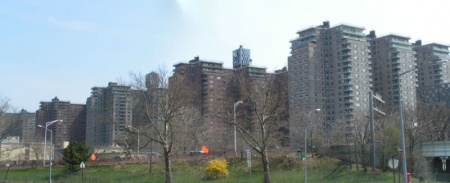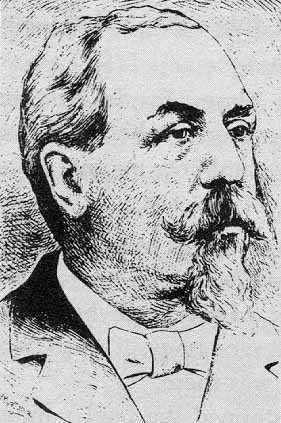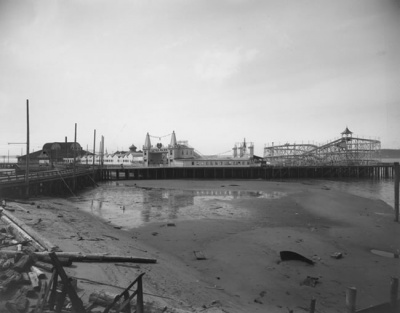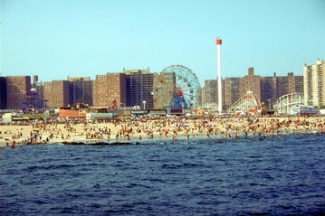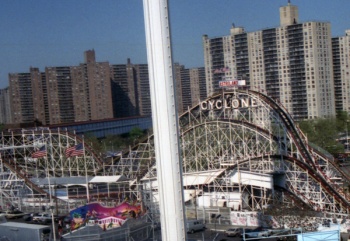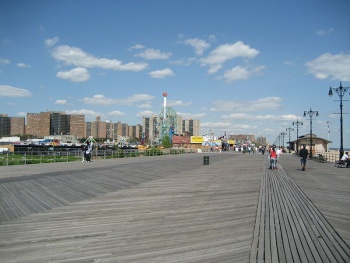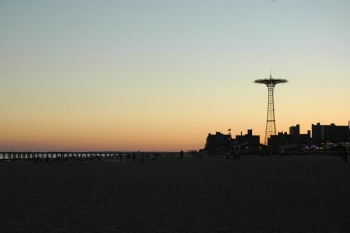Coney Island Turning PointsFrom The Peopling of New York City
The Early YearsConey Island began attracting visitors during the early 19th century. During the antebellum period, Coney slowly developed a line of bathhouses, taverns, restaurants, and a small steamboat service that linked the West End to New York City. For a long time, Coney Island offered a large public forum which was available to almost all classes and ethnicities. Coney's main objective was to provide temporary relief from the extremely enduring 19th century social conventions. Coney Island allowed for the relaxation of social boundaries and provided people with a portal to escape reality. Coney's mixture of seclusion and proximity to Manhattan also added to its appeal. The mid to late 1800s experienced high levels of gambling, robbery, and prostitution throughout the area, all of which helped make up the counterculture of Victorian America. Investors saw lots of promise in Coney Island. They realized that this beach community near the city could provide a great resort spot, and they began to pour their money into that very idea. Steamboat and railroad lines directed towards Coney were increased and more and more hotels were built along the beach. In 1878, Charles Feltman opened a 1,000 foot long iron pier, providing space for various games, food stands, and dancing floors. As early as 1878, an average summer Sunday saw an estimated 60,000 visitors to the area.[1] Coney continued to deny social conventions. Numerous saloons, sideshows, fortune tellers, and variety shows centered themselves around the newly constructed hotels and restaurants during the mid to late 19th century. In addition to the fun and games, Coney Island continued to be home for con men, whores, and thugs who finally found a popular place outside of the city where officials didn't care enough to stop them. Thanks to John Y. McKane, a local political boss through the final decades of the 19th century, Coney Island's enterprises flourished. It was under his administration that Coney Island earned the name "Sodom by the Sea."[2] McKane was eventually convicted of election fraud and left the country; thus having Coney give up the title of "Sodom by the Sea" and sending it into its thrilling amusement era. The rise of amusement parks throughout the first four decades of the 20th century marked a time of prosperity in Coney Island, one that gradually disappeared over time.
World War II Hits HomeWar in ConeyWorld War II brought fear to the residents within the United States. After the Pearl Harbor bombing, imminent destruction stood on the brink of everyone's mind. A war fought abroad for so many years could suddenly hit home. Coney Island was no different from the rest of the world. Visitor rates declined as people either stayed home or moved away from the area. The coastal areas were not the safest places to be. As Futrell write: "World War II was a mixed blessing for Coney Island. New attractions and maintenance materials were hard to come by, and its eight hundred thousand lights had to be dimmed to avoid attracting enemy attention."[3] Still, in light of the dreary feelings and darkness that lingered over everyone's head, Coney Island was still a "morale booster" during the wartime. As Bill Feigenbaum recollects: "The boardwalk in Coney Island was filled with soldiers and sailors. Music blared from the penny arcades. Even though all those terrible things were going on, the mood was up, patriotic."[4] In 1943, Coney Island amusement parks experienced one of their record seasons. This was a bit surprising because gasoline prices were high during the war. They had to turn to alternative fuel sources, such as naphtha (as reported by Matt Kennedy).[5] Naphtha is a type of chemical oil that is usually used in products such as camp fuel and lighter fluid, both of which are highly flammable.[6] Driving with Naphtha was like sitting in a time bomb waiting to go off.
Aftermath of the WarWhat happened to Coney?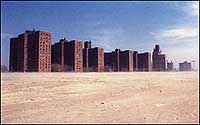 The housing skyline from the beach Source: Gotham Gazette After World War II and the Great Depression, Coney Island came back with a huge momentum in the late 1940s and early 1950s. “The soldiers, sailors, and marines returning home contributed to the area’s resurgence, and the general infusion of new money and disposable income helped stimulate Coney’s economy and boost the prospects of its merchants.” However, the momentum was short-lived as a series of incidents took Coney Island towards a full-scale decline. [7] In 1944, a fire broke out and destroyed half of Luna Park. This fire marked the end of Luna Park's prosperity, with more fires in 1946 and 1948 completely putting the park to ruins. Instead of attempting to rebuild the park, the land on which Luna Park sat was sold to developers with the plans of building a housing complex there.[8] It was in the late 1950s when the Luna Park Village housing complex was opened, consisting of five twenty story buildings.[9] Luna Park's destruction and purchase was just the first of many signs that Coney Island was entering a place of no return. Businesses around the area began to struggle due to fewer visitors to the area, and more and more chunks of land were being sold to housing developers with the hopes of building several apartment complexes for middle class families.[10] According to Census Bureau figures from 1961, Coney Island experienced a population decrease from 81,816, to 74,711 by 1957, and 72,792 in 1960.[11] In 1953, the land that Dreamland once stood on was sold, and in 1957, the New York Aquarium was built in its place. By this time, Steeplechase was the last remaining amusement park in the area.[12] Steeplechase had momentarily gained back its popularity with the influx of veterans coming back home from war. It was a glimmer of hope that Coney Island might return to the glorious state it was once in. But the mindset of many people changed in and around Coney Island. A once prominent amusement area slowly began to deteriorate with many public officials becoming concerned over the "increasing shabbiness" of the area. As concerns throughout the country turned towards public housing and possible ways for sheltering the increasing population, the need to revitalize Coney's amusement parks seemed to take a back seat.[13] By the end of 1964, Steeplechase closed, leaving Astroland (which opened in 1961 to reinvent the area) as the only amusement park in Coney Island.[14] As Berman stated: “Steeplechase, the simplest and oldest of the great Coney Island amusement parks, had outlasted the others, but it could not survive the wholesale decline of the neighborhood.”[15] The parks commissioner, Robert Moses (a.k.a. "the antichrist of Coney Island)[16], was working against Coney Island as well. He opposed the cheap amusements that the parks offered and guaranteed that the city did little to maintain this “fun zone”. According to Berman, “[Mose’s] goal was to [let] Coney Island [deteriorate to such an extent that it would encourage business flight and discourage visitors, thus making it an appropriate site for federally funded urban renewal.]”[17] Urban renewal, also known as “urban removal”, displaced the community’s least fortunate residents and totally destroyed the community before federal funds could be secured to rebuild the area. By this period in time, there were also more choices than before. More beach resorts opened in the New York area, and the availability of cars and the construction of better roads allowed middle-class families to travel and spend their leisure time elsewhere. [18] By the 1970s, Coney was broke due to lack of business. Crime had become a major issue in the area, and the once joyous streets and boardwalk were slowly deteriorating due to lack of interest by the city. Coney's time seem to have come to an end. [19]
Housing Developments
Construction of the first apartment complex began in the fall of 1955. The 1950s were a time in which Coney Island's neighborhoods became very tough places to live, including West End. Coney Island Houses, the name given to the initial housing project, was built in the West End. It consisted of five fourteen-story buildings, all of which were made with red brick in a utilitarian style. These housing units, surprisingly, helped the neighborhood and provided a nice place to raise a family for a few years.[20] Many factors would differentiate Coney Island Houses from its successors. The construction of this development displaced only eight residents and its size did not overwhelm the neighborhood, nor did it block any sunlight, like others eventually would. As residents of Coney Island Houses grew wealthier, they began to move out, thus distancing themselves from the lower classes of people. These houses, around the late 1950s, were populated mostly by European and Russian Jews, along with Blacks and Puerto Ricans. [21] For over ten years, Coney Island Houses remained the only high-rise apartment complex in the West End. As urban renewal came in and the obsession of public housing grew, the projects were "lost in a sea of buildings." The city came up with many plans for new buildings and continued to fill up the neighborhood. This excessive construction of buildings destroyed the area. As the 1960s came around, Coney Island was well on its path of deterioration and high crime levels. As those elements increased, residents of Coney Houses withdrew themselves from the community they once embraced. More and more people began leaving the area when the crime wave began.[22] In the early 1960s, Coney Island was slowly torn apart. Private developers wanted land along the beach for high-rise housing, the government wanted land for urban renewal projects, and racial tensions were creating a major image problem in the area.[23] In the summer of 1964, Coney experienced its worst season since 1937, which only suffered due to weather related issues. In 1964, concessionaires reported a business drop of 30 to 90 percent from the previous year. As an example, one can look at the actual amusement park rides and see obvious declines in their usage. The Wonder Wheel, which had 12,500 customers July 4, 1947, had just 4,174 patrons the previous Memorial Day. In 1963, the Wonder Wheel had attracted 10,000 people on average per weekend. In 1964, one year later, that number was down 3,000. The amusement park employees attributed the decline in business to many factors, including hoodlums, racial tension, inadequate parking, and public housing. Many concessionaires attributed the reluctance of the white customers to visit Coney Island to the growing number of Negro visitors. Teenage gangs had also grown to be very popular in the area at the time and they were always causing mischief in and around the amusement parks.[24] Inadequate parking could also be a reason why numbers were declining, but this implied a much larger reason. Many of the private parking lots had been replaced by the large housing developments in the area. By the looks of it, the public housing projects that were intended to benefit the area were only creating a larger rift between the old Coney and what was quickly becoming the new Coney. With only Astroland left in Coney Island to contend with the world, the decline of Coney Island was inevitable. There were several socio-economic factors that can be held accountable for the gradual decline of Coney, as mentioned already. And as economic conditions began to deteriorate through the mid-20th century, the city began to draw up plans devoting large sections of the neighborhoods to high density residential uses. As a result, plans for Trump Village and Warbasse, among others, were drafted by developers and put into the works.[25] Trump Village was named after Frederick C. Trump, who was a major a investor at the time who was trying his best to buy up all the land he could get his hands on to develop more housing. It was to be bounded by Neptune Avenue, Ocean Parkway, and West 5th Street. Warbasse was named after Peter Warbasse, and was to be located adjacent to Trump Village. Demolition was already underway by the early 1960s. Other public housing projects that were being considered at the time include numerous developments that were to be placed right on Surf Avenue, which was once the headquarters of many of the popular amusement parks that aided in Coney Island’s rise in fame.[26] Perhaps unbeknownst at the time, these housing developments would drastically change the face and attitude of Coney Island for many, many years.
A Changing IslandThe decline of Coney Island seemed to be directly related to the decline of Steeplechase Park. With the numerous urban renewal projects arising throughout the neighborhoods, Steeplechase began its steady decline into nothingness. The surrounding neighborhood had been in decline for several years and the park eventually closed in 1964. The park's closure dealt a large amount of damage to Coney Island. The Tilyou family, who owned Steeplechase, began looking for ways to sell the land, with hopes that the buyer would still maintain the essence of the park in some way. The family received many offers from developers, including one from Fred Trump, who hoped to build twenty-five story apartment buildings in its place. The Tilyou family ended up selling the land on April 20, 1965 to a man named Paul Futterman. After all was said and done, Paul Futterman was only fronting for Mr. Trump, who hid his identity and purchased the land for $2.2 million.[27] Instead of helping a struggling community, the development of low-income housing complexes in Coney Island saw only escalated gang violence among the youths of the neighborhood.[28] Concentrated pockets of poverty developed in these projects due to the low income families being brought in. The Coney Island of the 1960s and 70s would become known for its high levels of crime, arson, and racial unrest.[29] The old fun zone was now a place that instilled fear into its visitors. The Black and Puerto Rican population increased in the neighborhood, along with the hostility towards the working-class white visitors and residents. Fewer visitors came because of the declining surroundings and attractions to Coney Island. The increased racial tensions raised alarm in people for fear of riots breaking out.[30] In the late 1960s and 1970s, Coney Island became a symbol of urban decay and decline. It was seen as an impoverished neighborhood where drugs, crime, and hopelessness were prevalent, and a place where the local government had given up.[31] Public services and police presence in the community dropped greatly. Over time, people began looking for ways to get out of the area, and those who could leave did just that, leaving the poor behind.[32] According to Denson, the changes were unsettling at times, and it seemed as if the entire nation had forgotten about Coney Island. Coney was completely taken apart during this decade. By the middle of the decade, the city had gone broke and the federal government had cut off funding to the area, leaving a wasteland of unfinished projects. [33] The 70s were often characterized as the time in which the battle over the Cyclone took place. The Cyclone was once one of the most famous roller-coasters in the world, and is still in use today (it is now a landmark). The most relevant attack against the Cyclone came from Murray Raphael, who was president of Luna Park Houses at the time. The Cyclone is situated between the New York Aquarium and Astroland Park, and across the street from the Luna Park housing development. Raphael told the NY Times that his tenants had been complaining about all the noise coming from the roller-coaster, and as a result, he wanted the ride to be destroyed, which would have ruined Coney's legacy even further. [34] According to Charles Denson, Coney Island hit rock bottom around 1975. He writes in his book: "NYC was broke, the boardwalk was crumbling, landowners were abandoning their property, pollution closed sections of the beach, and successive fires destroyed historic buildings… The rows of new housing projects were often referred to as Coney Island's ‘tombstones.’”[35] The Cyclone may have been saved, but the rest of Coney continued to struggle. Most of the businesses along the boardwalk either closed or burned down during the 1970s. Coney became known throughout Brooklyn for prostitution. Prostitutes could be seen walking down Surf Avenue every late night, which is still the case today. Franchises were very reluctant about opening places in Coney Island due to the growing levels of undesired qualities. Arson and vandalism had become very commonplace on the boardwalk by this time. A newly opened KFC once had its power lines cut the night before the 4th of July so all the food would spoil for the year's biggest day of business. Word spread and Coney Island became an extremely undesirable place. Gangs began to develop within Coney Island as another result of the declining years. The most popular gang of the ‘70s was the Homicides, who many think the movie "The Warriors" was based on. [36] Despite all of this, some people still traveled into Coney, with its legacy still in their minds and wanting to experience a part of history. Some aspects of the amusement era remained, but in comparison to what it was 40 years earlier, it is not even close. Before the 1960s, racial issues were not much of a problem in Coney Island. The area had always been diverse with people of all ethnicities. The Coney Island Chamber of Commerce actively catered to black people, encouraging them to come and take part in the amusement. Violent crime really began to rise during the early 1960s.[37] Coney never was the safest of neighborhoods, but really took a turn for the worse during these years. In 1961, Fred Trump gained control over another large piece of land in a central Coney Island neighborhood often referred to at the time as “the Gut”. Trump's plans involved relocating the residents of the area so he could build the Trump Village high-rise building development. Much of this area had been occupied by poor blacks at the time, with some blue collar Irish and Italians as well. Trump began evicting many of these poor, long time residents for his slightly more expensive project. He relocated these poor residents to the long abandoned, summer bungalows in the West End. These bungalow colonies soon became "poverty pockets" of substandard housing.[38] The immediate effects of these colonies were tragic. Crime rate shot up to unprecedented levels and people tried getting out of the West End as quickly as possible, with the new Trump Village and Warbasse high rises being the desired destinations. As apartments were left empty in these pockets of poverty, the poorest and most desperate of people began moving in, causing the West End to deteriorate even more. In 1967, all of West End Coney Island was declared a poverty zone. The "Coney Island West Urban Renewal Program" was developed and it was decided to completely demolish the area, making way for more housing developments. The major question that rose was who these apartments would be built for. One side pushed for the renewal area to be for middle-income residents, while the opposing side pushed for lower-class residents. Thus far in Coney's decline, low-income housing projects had become centers for crime and trouble. Many council members predicted that this area would fall victim to this low-income death trap as well. Arguments continued over the renewal plan for a while, until in 1968, a deal to build a combination of low-income and middle-income housing projects was put in place. These projects would extend from Sea Gate to West 21st Street.[39] This plan would prove to be a major failure. The middle income tenants would eventually flee, and those who couldn't were forced to deal with another oncoming wave of crime, murder, and chaos. As Charles Denson says in his book, those who couldn't flee "became prisoners in their own homes." City budget cutbacks caused further neglect of Coney Island by City Officials, and as a result, housing police were very limited and crime levels were not getting any better.[40] Much of Coney would continue to be characterized by crime and poverty well through the 1970s. Nevertheless, New Yorkers, especially Brooklynites, never really gave up on Coney Island. Even in the worst of years, the beaches continued to be crowded on hot summer weekends. In addition, people with limited economic means still went to Coney Island’s beaches and boardwalk for the refreshing sea breezes and the opportunity to swim in the cool Atlantic waters. [41] “In the last two decades of the twentieth century, Coney Island has experienced somewhat of an upturn. While the neighborhood continues to struggle with poverty, unemployment, and ramshackle housing, there have been signs of recovery as thousands of New Yorkers are rediscovering Coney’s rich history,” write Berman.[42] There are still many attractions that draw visitors every summer such as the outdoor concerts, the legendary Cyclone roller coaster, Nathan’s famous hot dogs, and the annual Mermaid Parade. There is also the beach itself, which beckons the new generations to experience a taste of what Coney Island used to be.
Newspaper Articles/ Sources
References
|
